Performance Assessment of Advanced Daily Surface Soil Moisture Products in China for Sustainable Land and Water Management
Abstract
1. Introduction
2. Materials and Methods
2.1. Study Area
2.2. Data Collection
2.2.1. SMOS Data
2.2.2. SMAP Soil Moisture Products
2.2.3. FY-3 Soil Moisture Products
2.2.4. Blended Soil Moisture Products
2.2.5. Reanalysis and Model-Based Soil Moisture Products
- 1.
- ERA5
- 2.
- MERRA-2
- 3.
- SoMo.ml Product
2.2.6. In Situ Station Data
2.2.7. Auxiliary Data
2.3. Methods
2.3.1. Evaluation Preprocessing
2.3.2. Evaluation Metrics
3. Results and Discussion
3.1. Overall Product Evaluation
3.2. Spatiotemporal Performance of the Products
3.3. Product Performance Across Geographical Regions
3.4. Product Performance Across Different Dry and Wet Regions
4. Conclusions
4.1. Performance Comparison Among Product Types
- (1)
- In terms of evaluation metrics, SMAP products significantly outperformed other single-satellite products, with an ubRMSD of 0.11 m3/m3 and a R of 0.53, demonstrating the best agreement with in situ measurement data. However, under high surface moisture conditions, SMAP products showed a slight tendency to underestimate soil moisture. FY-3 soil moisture products exhibited the poorest performance. SMOS products performed moderately, with the SMOS_IC product slightly outperforming the SMOS L3 product. SoMo.ml products, blended soil moisture products, and land surface model products demonstrated superior spatial coverage; however, they tended to underestimate surface moisture levels.
- (2)
- In terms of spatiotemporal performance, SMAP and SMOS products exhibited generally consistent spatial patterns, with pixels showing high correlation coefficients mainly distributed in regions south of the Yangtze River. Among blended products, the SoMo.ml product performed best, exhibiting the highest proportion of grids with strong correlations. The two blended products and the two land surface model products showed similar spatial patterns of correlation coefficients between the validation pixels and ground station time series, with blended products showing high-correlation grids mainly south of the Yangtze River, and land surface model products showing concentrations primarily in southern China.
- (3)
- In terms of ascending and descending orbits, the differences between the ascending and descending orbit products of SMAP L3 were minimal. However, the descending orbit product of SMAP_IB outperformed that of SMAP L3. For SMOS, the ascending orbit product performed significantly better than the descending orbit product, while the difference between ascending and descending orbit products for SMOS-IC was much smaller compared to SMOS L3. For FY-3B, the ascending orbit product slightly outperformed the descending orbit product, whereas the opposite was observed for FY-3C.
4.2. Environmental Suitability and Practical Recommendations for Sustainable Development
Author Contributions
Funding
Institutional Review Board Statement
Informed Consent Statement
Data Availability Statement
Conflicts of Interest
References
- Babaeian, E.; Sadeghi, M.; Jones, S.B.; Montzka, C.; Vereecken, H.; Tuller, M. Ground, Proximal, and Satellite Remote Sensing of Soil Moisture. Rev. Geophys. 2019, 57, 530–616. [Google Scholar] [CrossRef]
- Seneviratne, S.I.; Corti, T.; Davin, E.L.; Hirschi, M.; Jaeger, E.B.; Lehner, I.; Orlowsky, B.; Teuling, A.J. Investigating Soil Moisture–Climate Interactions in a Changing Climate: A Review. Earth-Sci. Rev. 2010, 99, 125–161. [Google Scholar] [CrossRef]
- Song, X.; Li, Y.; Zhang, T.; Li, L.; Gu, T. Focusing High-Maneuverability Bistatic Forward-Looking SAR Using Extended Azimuth Nonlinear Chirp Scaling Algorithm. IEEE Trans. Geosci. Remote Sens. 2022, 60, 1–14. [Google Scholar] [CrossRef]
- Loew, A.; Holmes, T.; De Jeu, R. The European Heat Wave 2003: Early Indicators from Multisensoral Microwave Remote Sensing? J. Geophys. Res. 2009, 114, 2008JD010533. [Google Scholar] [CrossRef]
- Yang, C.G.; Liang, Y.; Bai, X.L.; Li, X. GLEAM Soil Moisture Data Evaluation and Its Spatiotemporal Characteristics in the Huaihe River Basin. China Rural Water Hydropower 2021, 52–57+66. [Google Scholar]
- Wu, J.; Gao, Y.H.; Pan, Y.J.; Jang, Y.S.; Li, Z.; Ma, J.N. Evaluation of soil-moisture simulations in the central and eastern Tibetan Plateau and error analysis. Chin. J. Geophys. 2020, 63, 2184–2198. [Google Scholar] [CrossRef]
- Wagner, W.; Naeimi, V.; Scipal, K.; De Jeu, R.; Martínez-Fernández, J. Soil Moisture from Operational Meteorological Satellites. Hydrogeol. J. 2007, 15, 121–131. [Google Scholar] [CrossRef]
- Das, K.; Paul, P.K. Present Status of Soil Moisture Estimation by Microwave Remote Sensing. Cogent Geosci. 2015, 1, 1084669. [Google Scholar] [CrossRef]
- Lakhankar, T.; Krakauer, N.; Khanbilvardi, R. Applications of Microwave Remote Sensing of Soil Moisture for Agricultural Applications. Int. J. Terraspace Sci. Eng. 2009, 2, 81–91. [Google Scholar]
- Taylor, C.M.; de Jeu, R.A.M.; Guichard, F.; Harris, P.P.; Dorigo, W.A. Afternoon Rain More Likely over Drier Soils. Nature 2012, 489, 423–426. [Google Scholar] [CrossRef] [PubMed]
- Albergel, C.; De Rosnay, P.; Gruhier, C.; Muñoz-Sabater, J.; Hasenauer, S.; Isaksen, L.; Kerr, Y.; Wagner, W. Evaluation of Remotely Sensed and Modelled Soil Moisture Products Using Global Ground-Based in Situ Observations. Remote Sens. Environ. 2012, 118, 215–226. [Google Scholar] [CrossRef]
- Dorigo, W.A.; Scipal, K.; Parinussa, R.M.; Liu, Y.Y.; Wagner, W.; De Jeu, R.A.M.; Naeimi, V. Error Characterisation of Global Active and Passive Microwave Soil Moisture Datasets. Hydrol. Earth Syst. Sci. 2010, 14, 2605–2616. [Google Scholar] [CrossRef]
- Dorigo, W.A.; Gruber, A.; De Jeu, R.A.M.; Wagner, W.; Stacke, T.; Loew, A.; Albergel, C.; Brocca, L.; Chung, D.; Parinussa, R.M.; et al. Evaluation of the ESA CCI Soil Moisture Product Using Ground-Based Observations. Remote Sens. Environ. 2015, 162, 380–395. [Google Scholar] [CrossRef]
- Yee, M.S.; Walker, J.P.; Rüdiger, C.; Parinussa, R.M.; Koike, T.; Kerr, Y.H. A Comparison of SMOS and AMSR2 Soil Moisture Using Representative Sites of the OzNet Monitoring Network. Remote Sens. Environ. 2017, 195, 297–312. [Google Scholar] [CrossRef]
- Beck, H.E.; Pan, M.; Miralles, D.G.; Reichle, R.H.; Dorigo, W.A.; Hahn, S.; Sheffield, J.; Karthikeyan, L.; Balsamo, G.; Parinussa, R.M.; et al. Evaluation of 18 Satellite- and Model-Based Soil Moisture Products Using in Situ Measurements from 826 Sensors. Hydrol. Earth Syst. Sci. 2021, 25, 17–40. [Google Scholar] [CrossRef]
- Liu, Y.; Yang, Y.; Yue, X. Evaluation of Satellite-Based Soil Moisture Products over Four Different Continental In-Situ Measurements. Remote Sens. 2018, 10, 1161. [Google Scholar] [CrossRef]
- Jin, L.; Wang, Y.F.; Guo, E.L.; Narenmandula; Gu, X.L.; Kang, Y. Applicability evaluation of ERA5, GLDAS and FLDAS soil moisture data in Inner Mongolia. Water Sav. Irrig. 2023, 3, 53–60. [Google Scholar] [CrossRef]
- Liu, Z.; Jiao, W.G.; Wang, X.Y.; Xu, G.H.; Wu, A.J. Evaluation of agricultural drought in Guizhou Province based on standardized soil moisture index. China Rural Water Hydropower 2022, 1–5. [Google Scholar] [CrossRef]
- Yang, W.J.; Li, J.Z.; Feng, P. Evaluation of agricultural drought in Luanhe River Basin based on the standardized soil moisture index. Ying Yong Sheng Tai Xue Bao = J. Appl. Ecol. 2022, 33, 801–807. [Google Scholar] [CrossRef]
- Zhu, H.W.; Luo, D.; Zhu, L.; He, W. Construction and evaluation of high spatial resolution soil moisture products based on random forest algorithm. Mod. Electron. Tech. 2023, 46, 153–158. [Google Scholar] [CrossRef]
- Zhang, Y.C.; Fu, X.L.; Ding, Y.J.; Jiang, X.L.; Zhong, Q. The study of downscaling SMAP surface soil moisture based on random forests in the source region of Yellow River. J. China Hydrol. 2024, 44, 22–29. [Google Scholar] [CrossRef]
- Peng, J.; Niesel, J.; Loew, A.; Zhang, S.; Wang, J. Evaluation of Satellite and Reanalysis Soil Moisture Products over Southwest China Using Ground-Based Measurements. Remote Sens. 2015, 7, 15729–15747. [Google Scholar] [CrossRef]
- Barre, H.M.J.P.; Duesmann, B.; Kerr, Y.H. SMOS: The Mission and the System. IEEE Trans. Geosci. Remote Sens. 2008, 46, 587–593. [Google Scholar] [CrossRef]
- Entekhabi, D.; Njoku, E.G.; O’Neill, P.E.; Kellogg, K.H.; Crow, W.T.; Edelstein, W.N.; Entin, J.K.; Goodman, S.D.; Jackson, T.J.; Johnson, J.; et al. The Soil Moisture Active Passive (SMAP) Mission. Proc. IEEE 2010, 98, 704–716. [Google Scholar] [CrossRef]
- Sun, Y.; Huang, F.; Xia, J.; Yin, C.; Bai, W.; Du, Q.; Wang, X.; Cai, Y.; Li, W.; Yang, G.; et al. GNOS-II on Fengyun-3 Satellite Series: Exploration of Multi-GNSS Reflection Signals for Operational Applications. Remote Sens. 2023, 15, 5756. [Google Scholar] [CrossRef]
- Dorigo, W.; Wagner, W.; Albergel, C.; Albrecht, F.; Balsamo, G.; Brocca, L.; Chung, D.; Ertl, M.; Forkel, M.; Gruber, A.; et al. ESA CCI Soil Moisture for Improved Earth System Understanding: State-of-the Art and Future Directions. Remote Sens. Environ. 2017, 203, 185–215. [Google Scholar] [CrossRef]
- Liu, J.; Zhan, X.; Hain, C.; Yin, J.; Fang, L.; Li, Z.; Zhao, L. NOaa Soil Moisture Operational Product System (SMOPS) and Its Validations. In Proceedings of the 2016 IEEE International Geoscience and Remote Sensing Symposium (IGARSS), Beijing, China, 10–15 July 2016; pp. 3477–3480. [Google Scholar]
- Hersbach, H.; Bell, B.; Berrisford, P.; Hirahara, S.; Horányi, A.; Muñoz-Sabater, J.; Nicolas, J.; Peubey, C.; Radu, R.; Schepers, D.; et al. The ERA5 Global Reanalysis. Quart. J. R. Meteoro. Soc. 2020, 146, 1999–2049. [Google Scholar] [CrossRef]
- Gelaro, R.; McCarty, W.; Suárez, M.J.; Todling, R.; Molod, A.; Takacs, L.; Randles, C.A.; Darmenov, A.; Bosilovich, M.G.; Reichle, R.; et al. The Modern-Era Retrospective Analysis for Research and Applications, Version 2 (MERRA-2). J. Clim. 2017, 30, 5419–5454. [Google Scholar] [CrossRef] [PubMed]
- O, S.; Orth, R. Global Soil Moisture Data Derived through Machine Learning Trained with In-Situ Measurements. Sci. Data 2021, 8, 170. [Google Scholar] [CrossRef] [PubMed]
- Caldwell, T.G.; Bongiovanni, T.; Cosh, M.H.; Jackson, T.J.; Colliander, A.; Abolt, C.J.; Casteel, R.; Larson, T.; Scanlon, B.R.; Young, M.H. The Texas Soil Observation Network:A Comprehensive Soil Moisture Dataset for Remote Sensing and Land Surface Model Validation. Vadose Zone J. 2019, 18, 1–20. [Google Scholar] [CrossRef]

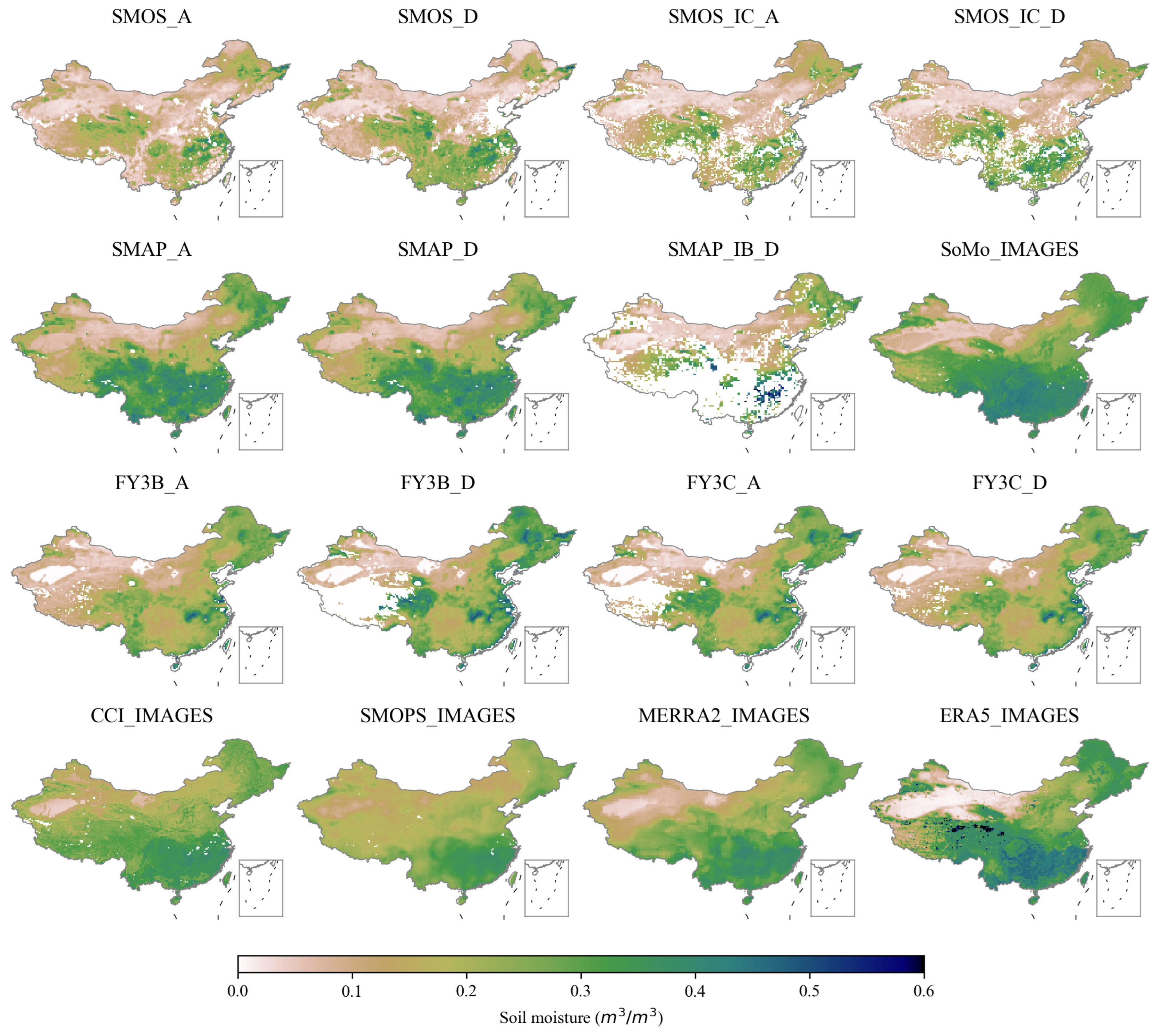
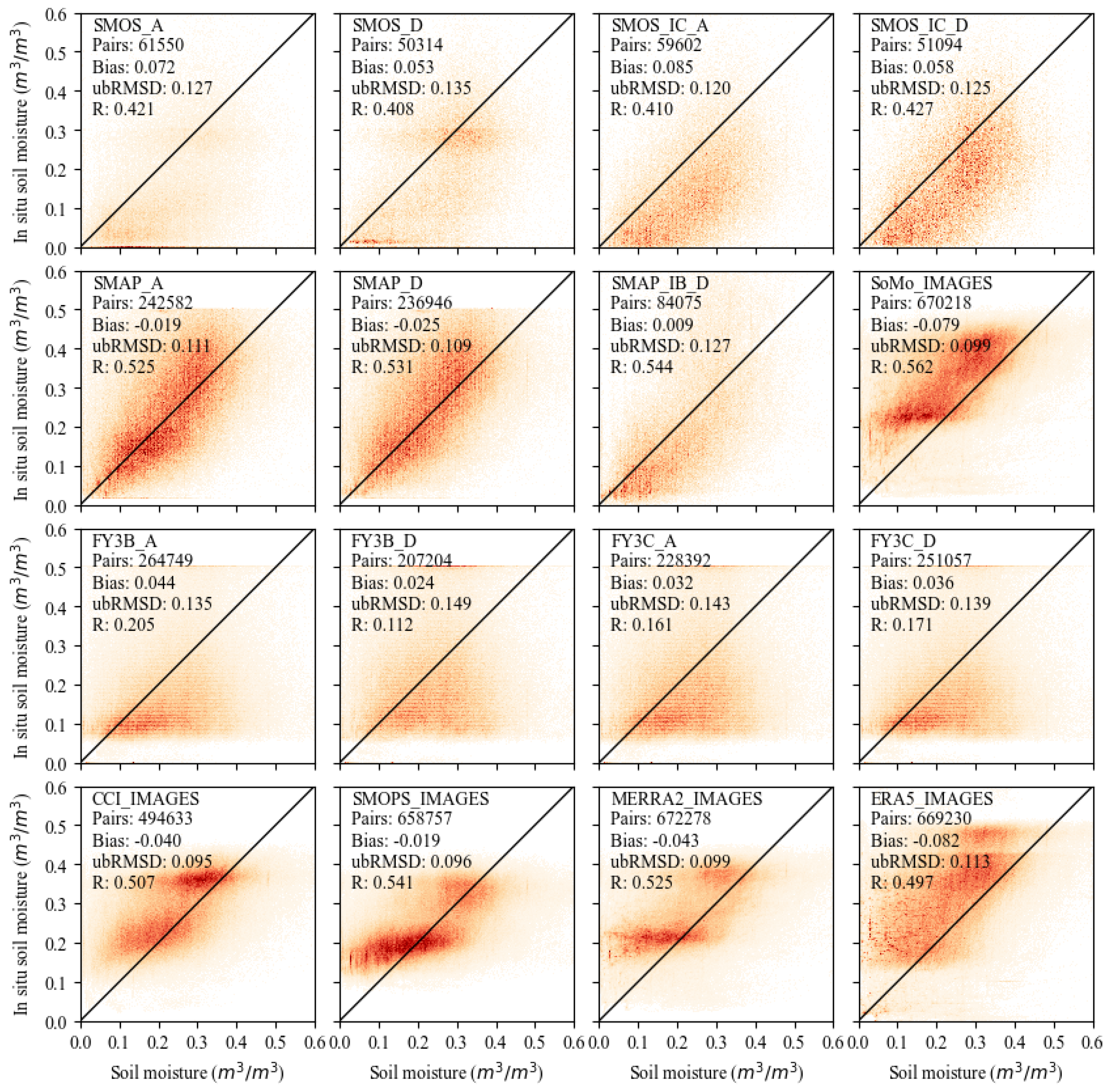
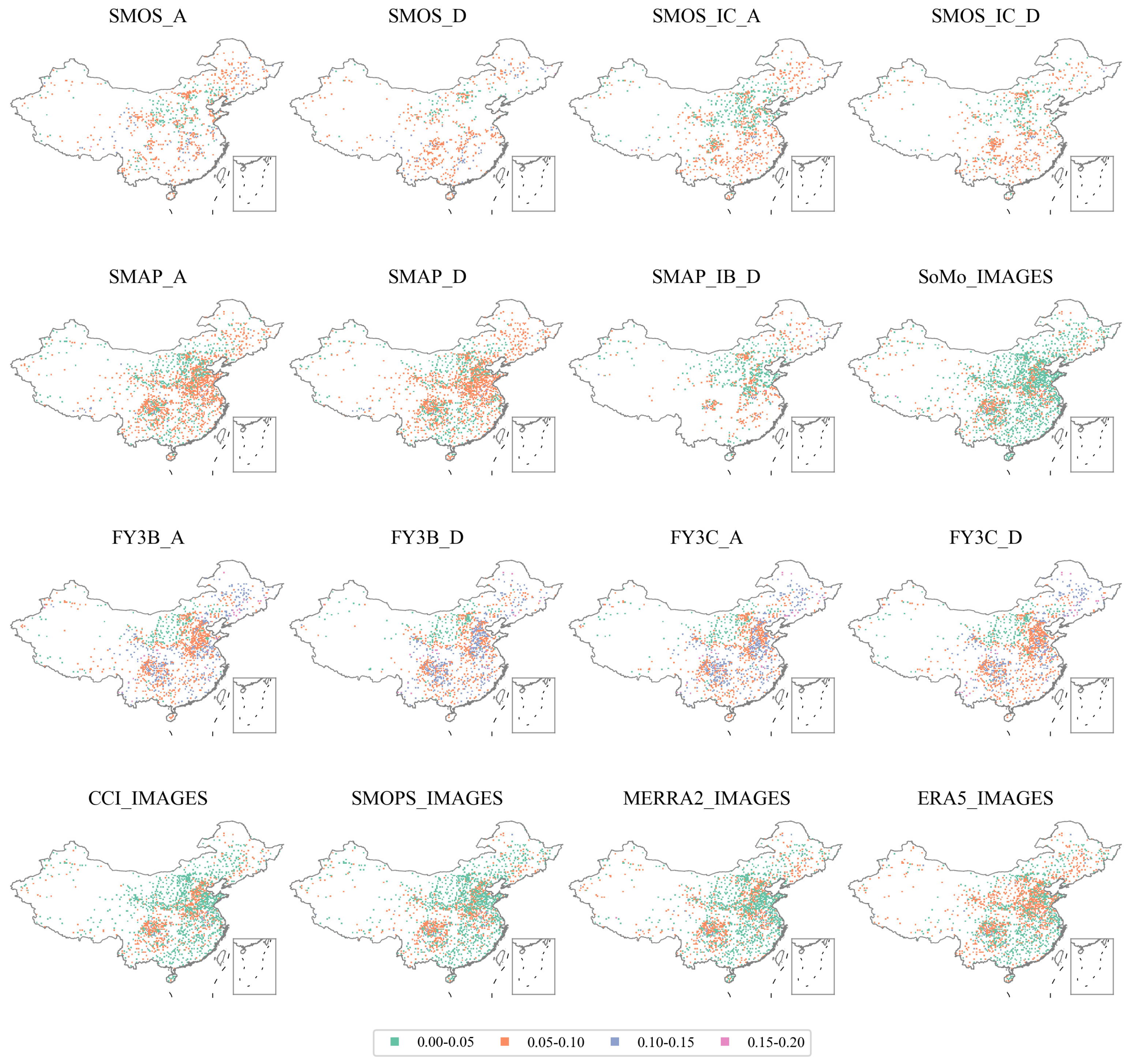

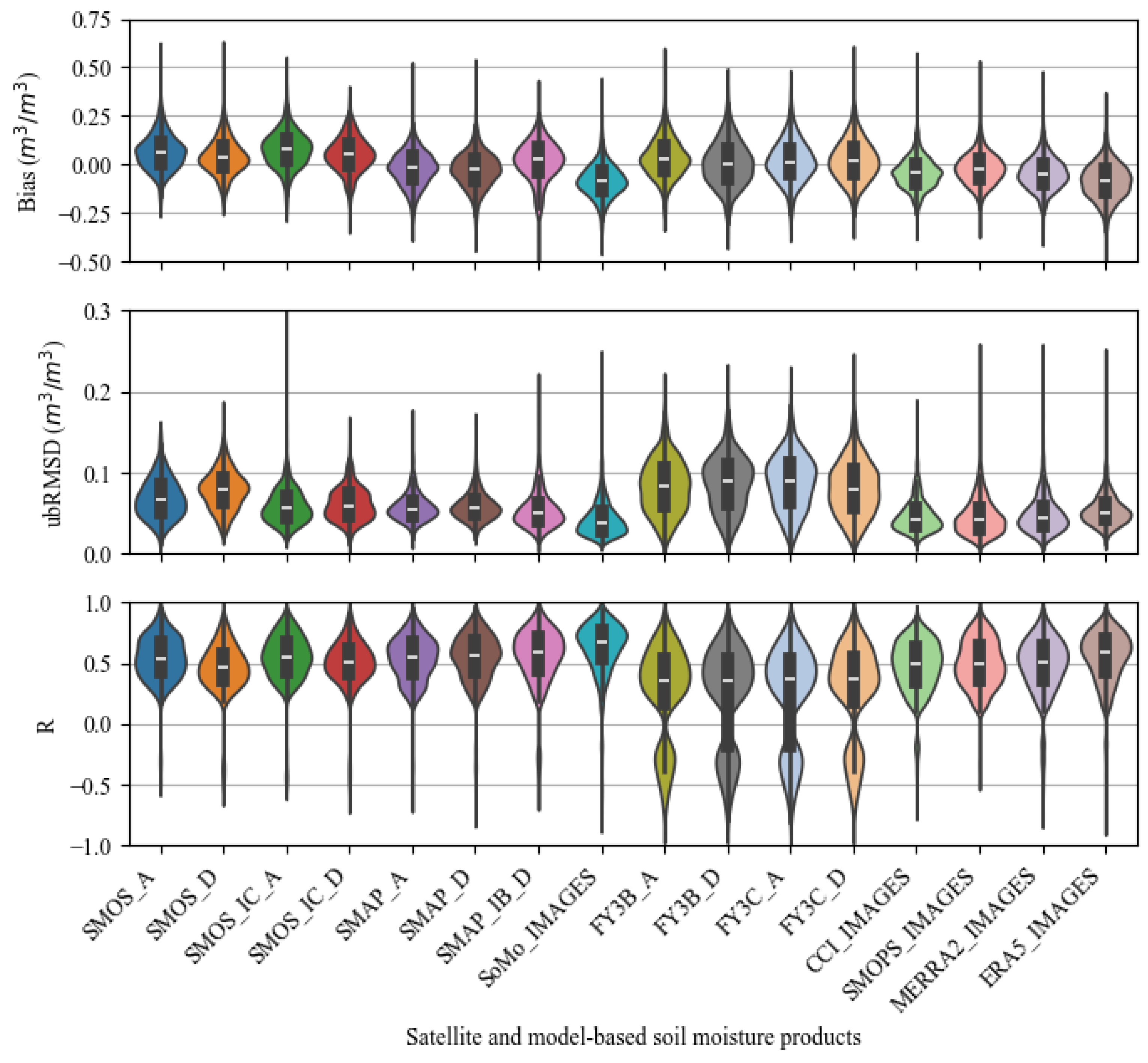
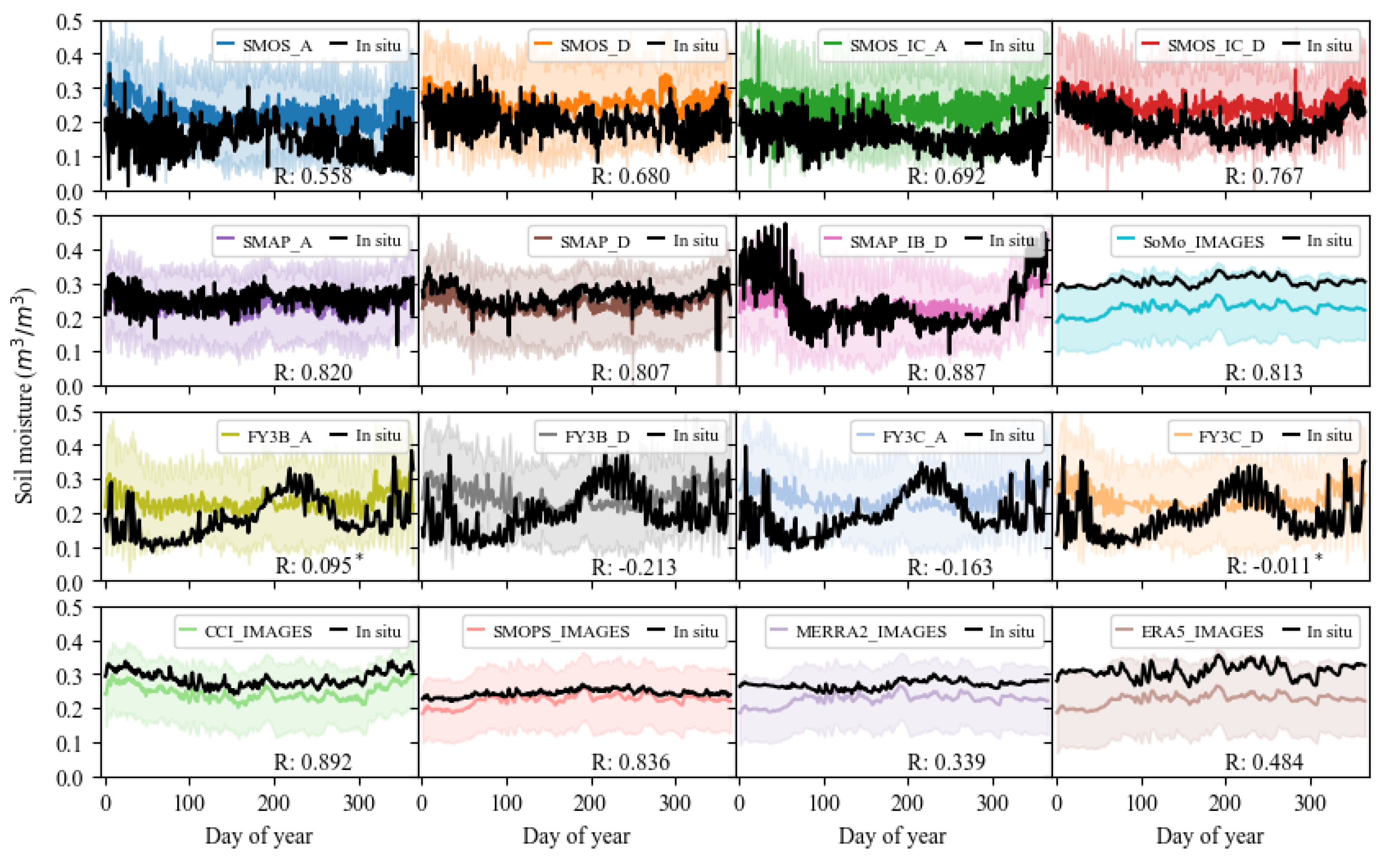
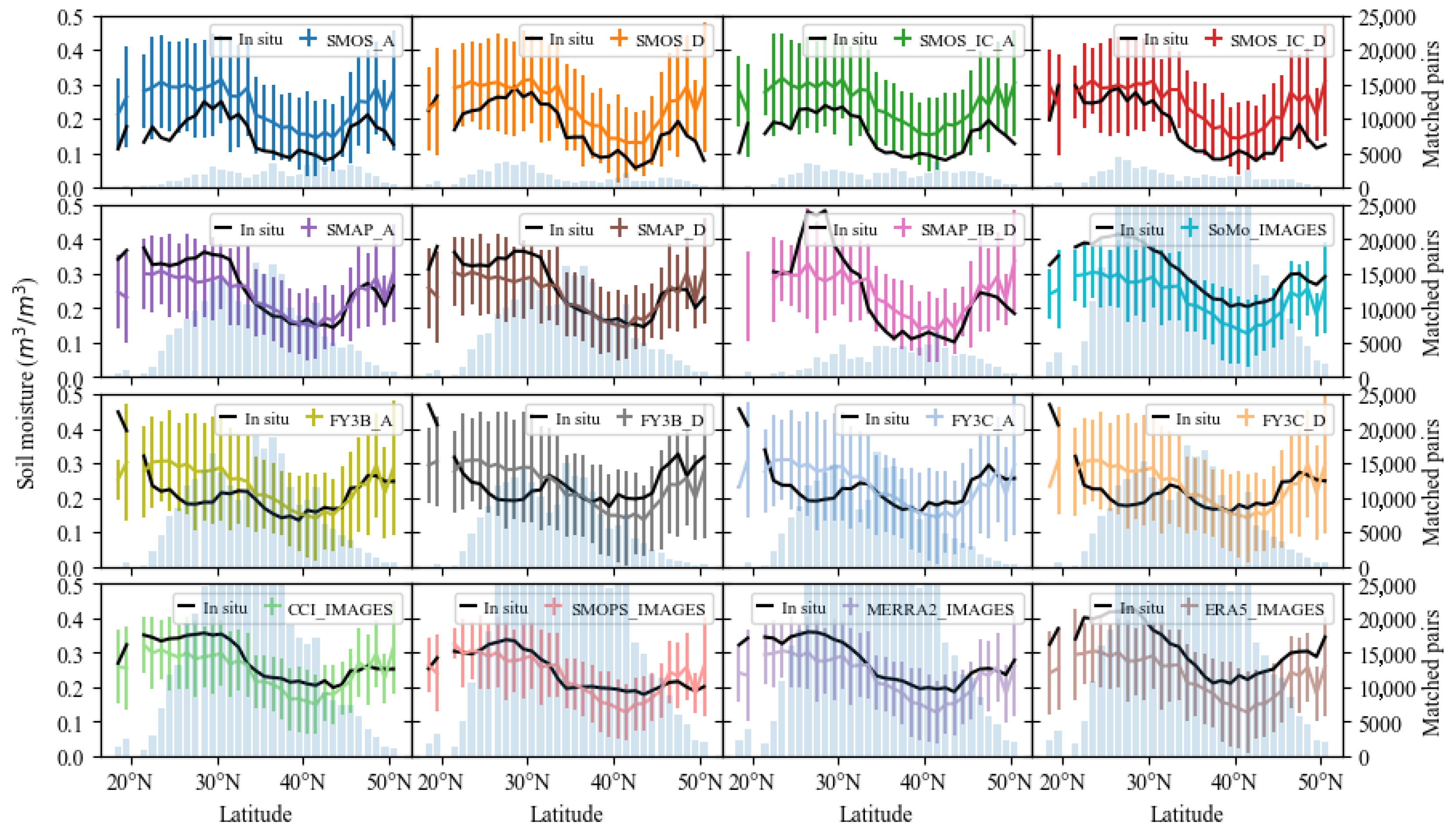
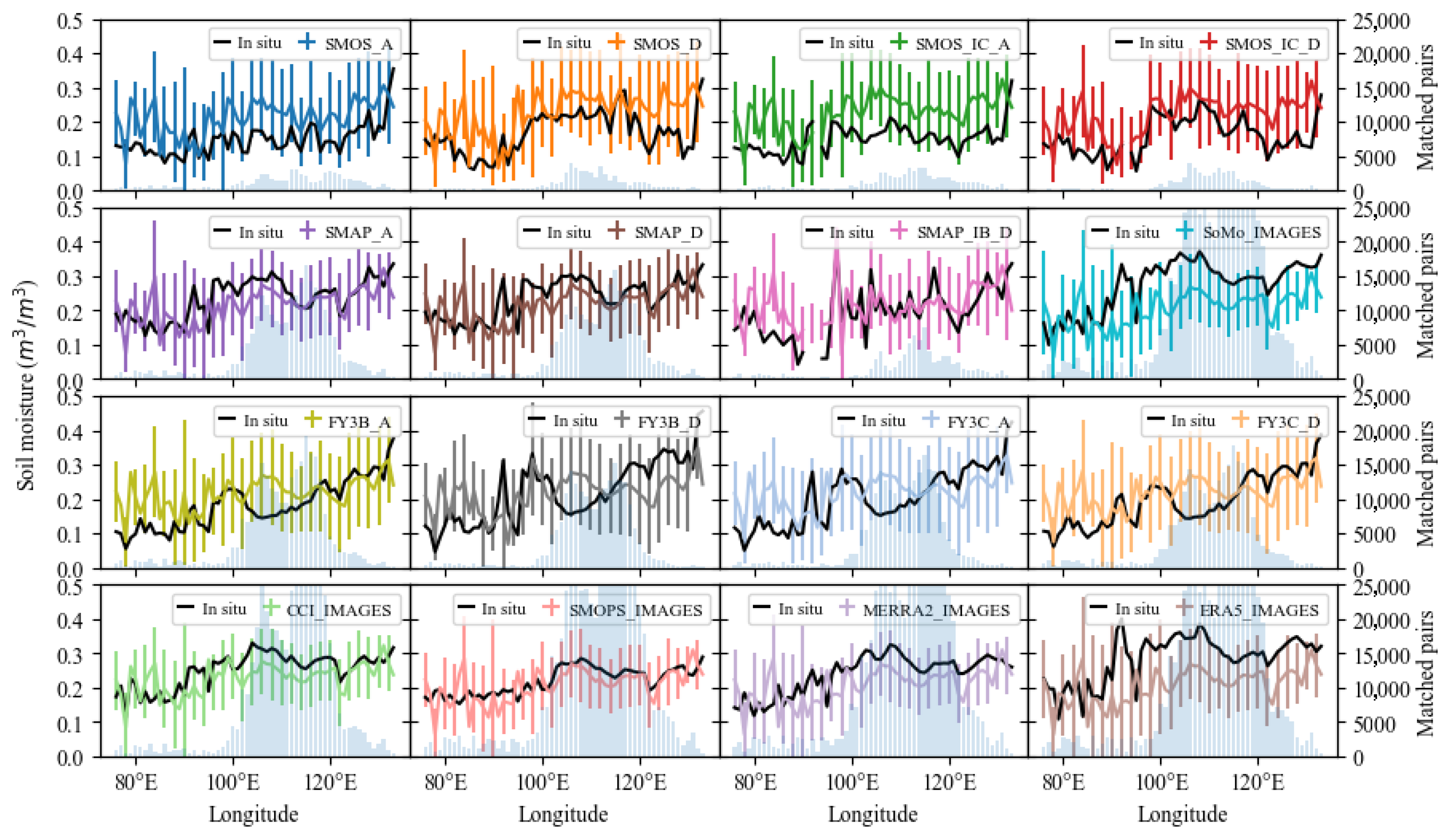

| Name | Temporal Resolution | Spatial Resolution | Grid | Coordinate System | Ascending Orbit/Descending Orbit | Level | Rows × Columns |
|---|---|---|---|---|---|---|---|
| SMOS L3 | Daily | 25 km | EASE-Grid2 | WGS84 EPSG:6933 | All | L3 | 584 × 1388 |
| SMOS_IC | Daily | 25 km | EASE-Grid2 | WGS84 EPSG:6933 | All | 584 × 1388 | |
| SMAP DCA | Daily | 36 km | EASE-Grid2 | WGS84 EPSG:6933 | All | L3 | 406 × 964 |
| SMAP-IB | Daily | 36 km | EASE-Grid2 | WGS84 EPSG:6933 | D | L3 | 406 × 964 |
| FY-3B | Daily | 25 km | EASE-Grid | International 1924 Authalic Sphere, EPSG:3410 | All | L2 | 586 × 1383 |
| FY-3C | Daily | 25 km | EASE-Grid | International 1924 Authalic Sphere, EPSG:3410 | All | L2 | 586 × 1383 |
| CCI | Daily | ~28 km | regular grid | WGS84 | None | / | 720 × 1440 |
| SMOPS | Daily | ~28 km | regular grid | WGS84 | None | / | 720 × 1440 |
| SoMo.ml | Daily | ~28 km | regular grid | WGS84 | None | / | 720 × 1440 |
| ERA-5 Land reanalysis | Hourly | ~9 km | regular grid | WGS84 | None | / | 1801 × 3600 |
| MERRA2 | Hourly | ~50 km | regular grid | WGS84 | None | / | 361 × 576 |
Disclaimer/Publisher’s Note: The statements, opinions and data contained in all publications are solely those of the individual author(s) and contributor(s) and not of MDPI and/or the editor(s). MDPI and/or the editor(s) disclaim responsibility for any injury to people or property resulting from any ideas, methods, instructions or products referred to in the content. |
© 2025 by the authors. Licensee MDPI, Basel, Switzerland. This article is an open access article distributed under the terms and conditions of the Creative Commons Attribution (CC BY) license (https://creativecommons.org/licenses/by/4.0/).
Share and Cite
Chen, D.; Dong, Z.; Chen, J. Performance Assessment of Advanced Daily Surface Soil Moisture Products in China for Sustainable Land and Water Management. Sustainability 2025, 17, 6482. https://doi.org/10.3390/su17146482
Chen D, Dong Z, Chen J. Performance Assessment of Advanced Daily Surface Soil Moisture Products in China for Sustainable Land and Water Management. Sustainability. 2025; 17(14):6482. https://doi.org/10.3390/su17146482
Chicago/Turabian StyleChen, Dai, Zhounan Dong, and Jingnan Chen. 2025. "Performance Assessment of Advanced Daily Surface Soil Moisture Products in China for Sustainable Land and Water Management" Sustainability 17, no. 14: 6482. https://doi.org/10.3390/su17146482
APA StyleChen, D., Dong, Z., & Chen, J. (2025). Performance Assessment of Advanced Daily Surface Soil Moisture Products in China for Sustainable Land and Water Management. Sustainability, 17(14), 6482. https://doi.org/10.3390/su17146482





